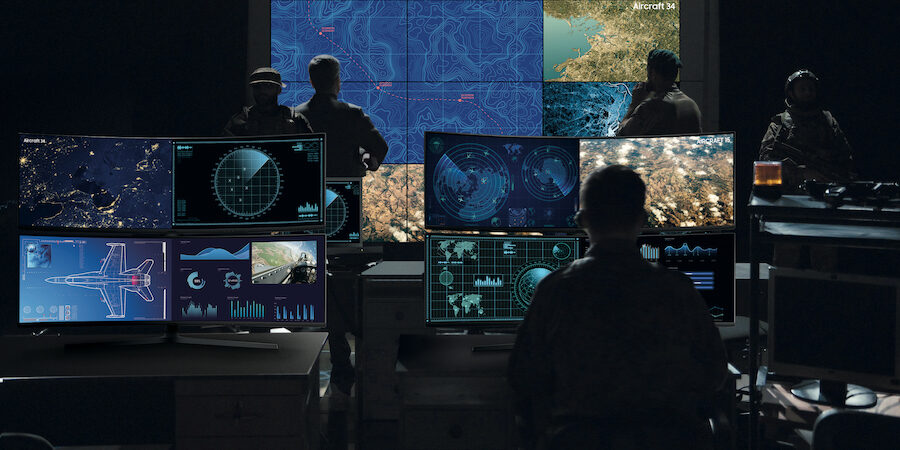Security is one of the biggest considerations for government organizations investing in new technology.
They need to be certain the hardware and software, as well as their vendors, don’t present a threat to the integrity of their mission-critical systems — from military and policing operations to the power grids, traffic control and security systems that support everyday life. Innovative and secure technology, built according to established guidelines, can deliver widespread peace of mind.
Security demands are particularly high for operations centers and control rooms that deploy large-scale video displays to provide multi-windowed views of what’s happening in real time. These screens need modern technology that locks out adversaries and prevents breaches, especially if the screens use Bluetooth and Wi-Fi.
What does it take to secure the displays of operation centers and control rooms? Here’s what you need to know:
Achieving TAA compliance
North America and Europe represent two of the biggest markets for professional video wall technology. Most of the components in these screens are designed and manufactured in Asia. That’s why compliance with the U.S. Trade Agreements Act (TAA) — the gold standard in security protocols for any digital display, including LED — has been widely adopted across the government sector as a requirement for video walls and a key factor in choosing control room technology vendors.
Originally developed more than 40 years ago, the TAA nurtures fair and open international trading of manufactured goods, including electronics. South Korea, home to Samsung headquarters, is TAA-compliant; China, Malaysia, Russia and India are among the countries that are not.
Sourcing TAA-compliant equipment provides more than just security for a video wall but also peace of mind for vendors in the government sector. Furthermore, companies can be fined or have government contracts canceled if they use non-compliant technologies.
Why security matters in control rooms
Security concerns in control rooms are well-founded in general because any networked device is a potential attack vector, including giant-screen displays. Threats abound, too. As recently as June 2023, the U.S. Department of Energy and other federal agencies were attacked as part of a global hacking campaign by an extortion group.
These attacks on government agencies are not abating, either, as more pile up by the day. They are expensive, too, with the global average cost of a data breach at $4.45 million in 2023. Plus, the vast majority of data breaches are financially motivated, as Verizon’s 2023 Data Breach Investigations Report underscored.
These threats underscore why it’s prudent to implement control room solutions that use TAA-compliant technology, such as The Wall All-in-One Non-Wi-Fi by Samsung, a giant-screen display that comes in 146-inch and 110-inch models, as well as 2K and 4K resolution options.
Transform government training for tomorrow
Discover how government agencies can harness the latest technology trends for training and learning. Download Now
A secure wall
An ideal video wall for a control room, The Wall All-in-One Non-Wi-Fi ships with a Linux-based Tizen OS, a cross-platform OS that offers built-in security right out of the box. It uses the same technology harnessed by Samsung Knox, a defense-grade enterprise mobile security solution. All Knox hardware has a Device-Unique Hardware Key (DUHK) to encrypt and decrypt data, as well as a hardware-isolated environment that limits program access.
Importantly, The Wall All-in-One Non-Wi-Fi has no Wi-Fi or Bluetooth connectivity. This extra layer of security is attractive to government agencies and private corporations adopting direct-view LED displays as large-format digital dashboards in their operations centers. Indeed, unsecured Wi-Fi and Bluetooth connections are particularly vulnerable to cyber intrusion, according to the Federal Communications Commission.
ISO-certified Samsung MagicINFO management software adds one more layer of security for government by giving them the ability to manage power and content remotely, as well as check the device’s health and performance. That means you don’t have to be physically present to ensure security.
A refined visual canvas
Premium visuals might seem like a luxury in an operations environment, but for government agencies and industrial applications, fine detail and true-to-life color can directly inform critical decisions that depend on visual data, including satellite, radar, seismic and high-resolution surveillance imaging.
The microLED technology inside Samsung video walls delivers a stunning viewing experience that meets all your video wall requirements and surpasses premium LCD flat-panel screens in quality. The “micro” refers to the tiny light pixels embedded in the display’s surface, which, combined with Ultra Chroma Technology, produces purer and more accurate colors than conventional LEDs. Black Seal Technology further enhances the pure black display levels to add greater depth and contrast. That’s ideal for everything from live video feeds and dynamic charting on key performance metrics to the granular details of schematics and mapping.
A wealth of security options
Depending on their viewing needs, control room operators and designers have a wealth of security considerations when selecting a video wall. Samsung answers many of these questions by providing information-rich, direct-view LED video walls that offer clear security benefits for government agencies’ day-to-day operations, including TAA compliance — a necessity for any modern control room.
Learn more about how command center monitors require advanced technology and have successfully supported public institutions, including fire departments.








